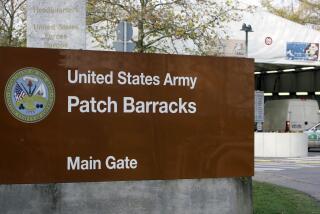Homeland Security Won’t Add Threat Hue
- Share via
WASHINGTON — The new Homeland Security Department’s color-coded threat system has been the butt of late-night comics and armchair critics, so it was probably inevitable that the colors themselves would come under fire.
Specifically, orange.
Rumors swept through Washington on Friday that the department was considering creating a new color--something between orange and red that would give it more latitude before resorting to the highest state of alert. A television news report prompted a flood of calls.
“I’ve heard it all: burnt orange, orange-plus, hard orange, even orange crush,” said a beleaguered Dennis Murphy, a Homeland Security spokesman.
But, added fellow spokesman Gordon Johndroe, there was absolutely no truth to the reports.
“While we know the system is not perfect, we’re not creating another level. We like the five colors we have now.”
The first three are green, blue and yellow. We’re usually at yellow these days -- but orange looms anew.
“If the president has to use military action to disarm Saddam Hussein, we’ll take the necessary measures to protect the homeland,” Johndroe said. “But that does not include adding another color.”
Jokes aside, the latest buzz put the spotlight back on a threat-level system that has broad effect on American life each time its colors change.
On the two occasions the level was raised from yellow to orange -- for two weeks in September and again for 20 days in February -- it cost state, local and federal governments millions of dollars in added manpower, overtime and other extras.
Financial analysts are now attempting to compute how much it costs to go from yellow to orange; so far, America has never been at red.
The sixth-color rumor was apparently prompted by a perceived need for more flexibility before going to the even more costly red alert.
But Murphy said orange already is broad enough to cover an array of discretionary actions.
“Orange is orange is orange, and there’s a whole range of things you can do,” he said. Just which orange measures are taken, and which are deferred, is decided on an “any or all-of-the-above” basis.
“At each level, there’s a lot of discretion. It all hinges on the threat,” Murphy added.
For example, he said, vehicle inspections at America’s borders are intensified at code orange. Just how intensive those inspections are -- how many cars and trucks are pulled over, for example -- is discretionary.
Although Homeland Security Secretary Tom Ridge is empowered to raise or lower the threat level, the decision is actually made by the little-known Homeland Security Council, a body headed by Ridge that includes the heads of the FBI, CIA and Defense Department, plus the vice president and the national security advisor.
A meeting of the council is the final step after intelligence assessments -- which take the pulse of threats to the nation twice daily -- have built an abundant case that America is facing a higher or lower threat than usual.
Ultimately, President Bush is consulted before colors change, Murphy said.
What would happen in case of war with Iraq?
“No decision has been made,” Murphy said of the council members. “Have they come together to decide, ‘Let’s raise the threat level?’ No, not to my knowledge.
“There are all kinds of plans and contingencies we’re working on and putting into place. But adding a new color? No. That’s not one of them.”
More to Read
Sign up for Essential California
The most important California stories and recommendations in your inbox every morning.
You may occasionally receive promotional content from the Los Angeles Times.













